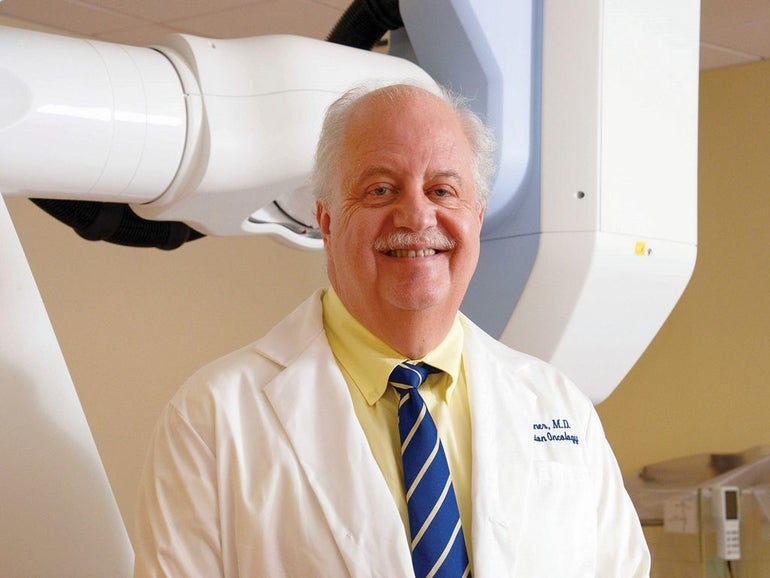Tackling Cancer, One Patient at a Time
 Dr. Mark Brenner, chief radiation oncologist at Saint Vincent Hospital in Worcester, says personalized treatment has upped the cancer cure rate in recent years.
Dr. Mark Brenner, chief radiation oncologist at Saint Vincent Hospital in Worcester, says personalized treatment has upped the cancer cure rate in recent years.
When people find out what Dr. Mark Brenner, the chief radiation oncologist at Saint Vincent Hospital in Worcester, does for a living, he says he often gets one response in particular.
“People are always saying ‘Oh my God, you must have the most depressing job in the world because you work with cancer.’”
Not even close, Brenner says. A lot of diseases—diabetes, congestive heart failure, hypothyroidism, and other ailments—can be controlled but seem to be far from a cure. With cancer, a steady stream of new developments means that, with more and more patients, it’s entirely reasonable to talk about curing their disease.
Over the last few years, these new discoveries have changed the face of cancer treatment. In many situations, it’s now possible to choose a course of action not just based on the type of cancer and how far it’s progressed but also the specific genetic sequences found in a tumor sample.
“Every area of cancer medicine has gone through light years of change in very recent times,” Brenner said.
Brenner compares the new diagnostic tools with the standard approach to a respiratory tract infection. A doctor can take a swab from a patient, send it to a lab for culture, and determine not just that the infection is bacterial but the precise antibiotic that will do the best job fighting it.
“It’s much more individualized treatment,” he said. “It’s much more personal.”
The advantage is not just that cancer treatments chosen using genomic testing are more precisely tuned to a particular patient’s disease but that it avoids overtreatment. If a treatment that stimulates an immune response is very likely to be sufficient, there may be no need to use aggressive methods like chemotherapy.
“You don’t want to take an elephant gun when a fly swatter will suffice, and neither do you want to take the fly swatter when you need the elephant gun,” Brenner said.
Personalized therapy not so novel?
Dr. Alan Rosmarin, chief of hematology/oncology at UMass Memorial Medical Center in Worcester, said that, depending on how you define it, personalized cancer care has been happening for decades. Even years back, doctors looked for estrogen or progesterone receptors on breast cancer patients’ tumors to determine whether the cancer was likely to respond to hormonal treatments.
The difference today is the range of tools that are available and the variety of ways they can be applied, said Rosmarin, who is a member of the American Cancer Society’s New England Division board of directors. Instead of just looking at one or two characteristics of a tumor, doctors may sometimes sequence hundreds of genes to find out more about how it operates. The jump forward is due largely to the international human genome project funded by the U.S. government, which was completed in 2003 and produced findings that medical science continues to build on.
“We now have a complete atlas, if you will, of all conventional genes and proteins,” Rosmarin said.
Add to that the falling cost of sequencing DNA and it’s now possible to gather huge amounts of data not just for research purposes but to determine a course of treatment for an individual patient.
Rosmarin said how much testing is done in any particular case depends on the patient’s situation and also the type of hospital they visit. As a basic standard of care, all doctors should examine biomarkers for a tumor.
Of course, which kinds of testing are appropriate depends on the patient. When he encounters an apparent case of acute leukemia, Rosmarin said, the key is acting quickly, running bone marrow tests to determine what variety of the disease it is. Some variants must be treated in completely different ways from others, he said. But, if diagnosed promptly and accurately using the new personalized diagnostics, some patients who would have had low chances of survival a few years ago can now be treated successfully.
But Rosmarin noted that diagnosis is not a simple matter of feeding samples into a computer and letting it spit out results. Finding genetic mutations in a sample isn’t necessarily the key to a diagnosis since all of us, not just those living with cancer, have many mutations in our DNA. Meanwhile, each cancer is changing and evolving.
“They can make computers that can just crank out this information,” Rosmarin said. “It’s the analysis that matters… It’s more subtle than ‘let’s sequence that and we’ll get an answer.’”
And then, there’s the question of treatment. Ideally, identifying particular aspects of a tumor can let a doctor know what treatment is best. But even if you can find the key mutations that seem to be causing the cancer, there isn’t always a matching treatment.
“If we don’t have the tool that attacks it, that doesn’t help very much, does it?” Rosmarin said.
Research, industry pursue personalization
Of course, scientists at research institutions and private companies are constantly at work looking for new tools. In Worcester, Nemucore Medical Innovations is working on treatments for several types of cancer, with clinical trials currently taking place. The company’s chief science officer, Barbara Davis, said the drugs’ personalization involves not just the treatment itself but the method of delivery.
“We’re modifying how that drug can get into the brain or get into the tumor,” Davis said. “So the idea is that we can target our drugs to the tumors and hopefully then we don’t have as much toxicity. Because some of these drugs are potent. They can cause trouble with other organs.”
Davis said the clinical trials the company is conducting recruit patients who have not found success with standard treatments, or who have come out of remission. Using genomic sequencing, she said, the company is able to work with patients’ doctors to determine who would be likely to respond to Nemucore’s treatments. She said the process is possible thanks partly to the growing use of the genetic tests.
“It’s actually getting more and more routine, and financially reasonable,” she said. “Plus the insurance companies are really supporting this right now. So it is more common than not now to have patients come in and get a genetic screen of their tumor.”
When it comes to ovarian cancer, which is one of Nemucore’s major focuses, Davis said the company is hopeful that one of the drugs it has in development will be able to handle a specific set of mutations. She said as diagnostics advance, the idea is to make these targeted therapies the go-to treatment for particular patients, entirely avoiding the blunter instruments like chemotherapy when possible.
“I think we’re all so hopeful that this is the future of cancer treatment,” she said.
Localizing treatment
Along with new technological tools, the business models of local Central Massachusetts hospitals are also bringing cutting-edge science to more patients. Milford Regional Medical Center, for example, worked with Dana-Farber/Brigham and Women’s Cancer Center to open its cancer center in 2008. Center Director Dr. Michael Constantine said patients can generally get whatever tests and treatment they need right in Milford, although they do refer some cases, like acute leukemia, to tertiary hospitals.
“Ninety to 95 percent of the time we can give care here, with all the services we have,” Constantine said.
As a part of the Dana Farber organization, he said, he has access to experts researching new techniques, and the center participates in clinical trials, giving patients access to experimental treatments when it seems appropriate. Like everyone in his field, Constantine said, he also has to work hard to keep up with the new advances.
“I’ve got to keep reading every day because every day it’s something different,” he said.
Finding common ground
One of the ways research is moving forward fast is identifying commonalities between different types of cancer. For example, Constantine said, doctors knew that a particular receptor in breast tumors made it susceptible to a particular treatment. When they investigated gastric cancers, they discovered that the same receptor was found in about 10 percent of them—and those cancers could be treated with that same medication.
Meanwhile, Constantine said, some lung cancers have a telltale mutation that can be targeted with a pill. Not only is it an effective treatment, but it saves patients from grueling hours dealing with the side-effects of more invasive methods.
“They’re not coming in every day to get IV chemotherapy, they’re not coming in for blood counts, and they’re not living here at the center, which is a good thing,” Constantine said.
The upshot, for all sorts of cancer, is that patients are benefitting right now from advances in personalized medicine, and more treatments are coming down the pike all the time.
“It’s moving forward so rapidly,” Constantine said. “There’s just so much going on. It’s great. People are living longer, and they’re not just living longer, they’re living better.”
Of course, none of this means that cancer is ever an easy diagnosis for a patient to deal with. But Constantine said he’s happy with the message he’s able to give people who come to him feeling terrified.
“Sometimes people can have the diagnosis of cancer and feel hopeless, but they shouldn’t, no matter what,” he said. “There’s hope in improving the quality of life and keeping the quality of life up, and even cures.”













0 Comments